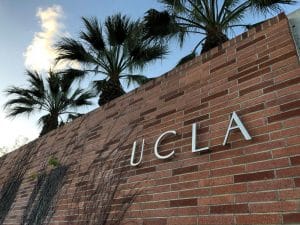The UCLA Common Data Set
If you’re looking for information on a university’s demographics, academic offerings, and financial aid statistics, look no further than the Common Data Set. In this article, we’ll go in-depth on the UCLA Common Data Set, decoding its sections and exploring what it means for the university and its students.
Understanding the Common Data Set
The Common Data Set or CDS is an annual survey that collects university data on demographics, enrollment, admissions, academic policies, campus life, expenses, and financial aid. Higher education institutions use the collected data to benchmark themselves against other colleges and universities. However, you don’t have to be an admissions officer to find value in the CDS. Researchers, students, and parents alike can use the information collected to understand what makes each university unique.
What is the Common Data Set?
The CDS is a standardized report that universities are required to fill out every year. The report is used to provide clear and consistent information on university statistics. It was first introduced in 1997 to simplify the college search process by reducing overlap in college surveys and streamlining the data collection process. Since then, the CDS has become a valuable tool for analyzing trends that impact higher education institutions across the country.
The CDS is divided into several sections, including general information about the university, enrollment and persistence, admissions, academic offerings and policies, student life, annual expenses, and financial aid. Each section contains detailed information about the university, such as the number of students enrolled, the percentage of students receiving financial aid, and the types of academic programs offered.
Importance of the Common Data Set in Higher Education
The CDS is an important tool for understanding and comparing universities. If you’re a student applying for colleges, the data can help you compare and contrast the institutions you’re considering. For example, you can use the CDS to compare the average SAT scores of admitted students or the percentage of students who receive financial aid. This information can help you make informed decisions about where to apply and ultimately where to attend.
The Common Data Set can also help universities understand how they stack up against their peer institutions. By comparing their data to other universities, they can identify areas where they excel and areas where they need improvement. This information can be used to make strategic decisions about admissions, financial aid, and campus life.
How Universities, like UCLA, Use the Common Data Set
The CDS is used by universities in many ways. At UCLA, administrators use the collected data to help inform admissions decisions and campus policy. For example, if the CDS data shows that the majority of students are from out of state, the university may decide to focus on recruiting more in-state students. Similarly, if the data shows that a large percentage of students are majoring in a particular field, the university may decide to invest more resources in that department.
The CDS data can also help universities identify areas where they need to improve. For example, if the data shows that the university has a low retention rate, the university can use that information to reevaluate academic and campus programs to better support students.
In conclusion, the Common Data Set is a valuable tool for understanding and comparing universities. Whether you’re a student, researcher, or parent, the information collected in the CDS can help you make informed decisions about higher education.
Key Components of the UCLA Common Data Set
General Information and Demographics
This section of the CDS provides general information about the university, such as the campus size and the breakdown of the student body by race and gender. UCLA is located in the heart of Los Angeles and has a sprawling campus that spans over 419 acres. The campus is home to a diverse student body of over 44,000 students, with a relatively even split between male and female students. The report also shows that the student population is predominantly Asian and white, with Black and Hispanic students making up a smaller percentage of the student body.
UCLA’s location in Los Angeles provides students with access to a vibrant and diverse city, with endless opportunities for cultural exploration and entertainment. The university is also home to a range of student organizations and clubs, providing students with opportunities to connect with like-minded individuals and pursue their passions outside of the classroom.
Enrollment and Persistence
The enrollment and persistence section of the UCLA Common Data Set provides data on admissions, applications, and enrollment. The report shows that UCLA has an extremely competitive admissions process, with a low acceptance rate of just 12.4% for first-year students. However, for students who are admitted, UCLA provides a supportive and engaging academic environment that encourages persistence and success. The report shows that once students are enrolled at UCLA, they tend to persist, with a 92.1% first-year retention rate.
UCLA’s commitment to student success is reflected in its range of academic resources and support services. The university provides students with access to academic advisors, tutoring services, and study groups, all of which are designed to help students achieve their academic goals and succeed in their coursework.
First-Year Admission Statistics
This section provides information on the academic profile of admitted first-year students, including average test scores, class rank, and GPA. The report shows that admitted first-year students at UCLA tend to have strong academic profiles, with an average GPA of 4.18, an SAT score of 1454, and an ACT composite score of 32. These impressive academic credentials are a testament to the university’s commitment to academic excellence and its rigorous admissions process.
UCLA’s commitment to academic excellence extends beyond its first-year students. The university provides all students with access to a range of academic resources and support services, including academic advisors, tutoring services, and study groups. These resources are designed to help students achieve their academic goals and succeed in their coursework, regardless of their academic background or level of preparation.
Transfer Admission Statistics
The transfer admission statistics section shows the number of transfer students who applied, were admitted, and enrolled at UCLA. The report shows that UCLA admitted 54.6% of transfer applicants and had an enrollment rate of 39.6% for transfer students. These statistics highlight the university’s commitment to providing opportunities for students to transfer into UCLA and continue their academic journey at a top-ranked institution.
UCLA’s commitment to transfer students extends beyond its admissions process. The university provides transfer students with access to a range of academic resources and support services, including academic advisors, tutoring services, and study groups. These resources are designed to help transfer students succeed in their coursework and achieve their academic goals.
Academic Offerings and Policies
This section of the CDS provides information on the academic offerings and policies at UCLA. Some of the data includes the number of undergraduate majors, student-faculty ratio, and faculty diversity. The report shows that UCLA has an impressive number of undergraduate majors available, with over 130 options. The university also has a relatively low student-faculty ratio of 18:1, suggesting a strong focus on personalized instruction.
UCLA’s commitment to personalized instruction is reflected in its range of academic resources and support services. The university provides students with access to academic advisors, tutoring services, and study groups, all of which are designed to help students achieve their academic goals and succeed in their coursework. Additionally, UCLA’s faculty is diverse and highly qualified, providing students with access to a range of perspectives and expertise.
Student Life and Campus Resources
In this section of the CDS, you’ll find details on student housing, campus safety, and student resources. The report shows that 33% of undergraduates live on campus, but that the university also has a range of off-campus housing options. Additionally, UCLA has a robust campus safety program that includes 24/7 police coverage and a range of student services and clubs.
UCLA’s commitment to student life extends beyond its housing and safety programs. The university provides students with access to a range of student organizations and clubs, providing opportunities for students to connect with like-minded individuals and pursue their passions outside of the classroom. Additionally, UCLA’s commitment to diversity and inclusion is reflected in its range of cultural centers and resources, which provide students with opportunities to explore and celebrate their identities.
Annual Expenses and Financial Aid
The financial aid section of the CDS is one of the most important, as it can help students understand the affordability of higher education. The report shows that the average cost of attendance for in-state undergraduates at UCLA is $35,793, with out-of-state students paying $65,551. However, UCLA also has a range of financial aid options available, with 57% of students receiving some form of aid.
UCLA’s commitment to affordability and accessibility is reflected in its range of financial aid options and support services. The university provides students with access to financial aid advisors, scholarship opportunities, and work-study programs, all of which are designed to help students afford the cost of higher education and achieve their academic goals.
Faculty and Class Size
This section provides information on the faculty and class size at UCLA. Among the data, you’ll find the number of full-time and part-time faculty, as well as the percentage of classes that have fewer than 20 or more than 50 students. The report shows that UCLA has a diverse faculty, with a relatively equal split between male and female faculty members. Additionally, roughly 52% of classes have fewer than 20 students, suggesting a focus on small class sizes and personalized instruction.
UCLA’s commitment to personalized instruction and small class sizes is reflected in its range of academic resources and support services. The university provides students with access to academic advisors, tutoring services, and study groups, all of which are designed to help students achieve their academic goals and succeed in their coursework. Additionally, UCLA’s faculty is diverse and highly qualified, providing students with access to a range of perspectives and expertise.
Analyzing the UCLA Common Data Set
Trends in Enrollment and Admissions
One trend that is apparent in the UCLA Common Data Set is that the university is becoming increasingly competitive. Over the past decade, UCLA’s acceptance rate has dropped significantly, from 20.1% for first-year students in 2011 to 12.4% in 2020. Additionally, the university has seen a significant increase in applications, with a 68% increase in first-year applications and a 65% increase in transfer applications over the past decade.
Diversity and Inclusion at UCLA
Another important trend that the CDS highlights is UCLA’s efforts to promote diversity and inclusion on campus. While the report shows that the UCLA student population is still predominantly Asian and white, the university has made strides in recent years to increase diversity. For example, the percentage of Black and Hispanic students has increased by roughly 10% since 2015, and the university has implemented a number of programs to support underrepresented students.
Graduation and Retention Rates
The graduation and retention rate section of the CDS shows that UCLA has a relatively high retention rate compared to other universities. However, the graduation rate is slightly lower than the university’s retention rate, suggesting that some students may struggle to graduate on time. Additionally, the CDS highlights the importance of factors such as academic support and financial aid in helping students persist and graduate.
Financial Aid and Affordability
Finally, the financial aid section of the CDS highlights the importance of affordability in higher education. While UCLA is an expensive university, the CDS shows that the university has made efforts to support students who may struggle to afford tuition. Additionally, the report shows that the university offers a range of resources and programs to help students manage the costs of attendance.
Final Thoughts
The UCLA Common Data Set is a valuable tool for understanding what makes the university unique. Whether you’re a student trying to decide where to apply or an administrator making policy decisions, the CDS can help provide insight into the university’s demographics, academic offerings, and financial aid statistics. By decoding the report and analyzing its trends, you can gain a deeper understanding of what makes UCLA one of the top universities in the country.
How AdmissionSight can help you with college admissions
AdmissionSight is a college consulting firm that provides personalized assistance to students throughout the college admissions process. Here are some ways that AdmissionSight can help you:
Admissions strategy: AdmissionSight can help you develop a strategic plan for your college application process. Our professional consultants can assist with identifying schools that are a good fit for your academic, extracurricular, and personal goals and help you plan and prioritize your application strategy.
Application review: AdmissionSight can review your application and provide feedback on how to improve it. We can offer suggestions on how to make your application stand out and highlight your strengths and unique qualities.
Essay coaching: AdmissionSight can help you craft compelling essays that showcase your personality, goals, and achievements. We can guide you through the essay writing process and provide feedback on your drafts to help you refine your writing.
Interview preparation: AdmissionSight can provide interview coaching to help you feel confident and prepared for your college interviews. Our experts can offer tips on how to present yourself professionally and how to answer common interview questions.
Extracurricular planning: AdmissionSight can help you plan and develop your extracurricular activities to make them more impactful and meaningful. We can suggest activities that align with your interests and goals and provide guidance on how to demonstrate your leadership and initiative.
Overall, AdmissionSight can provide valuable guidance and support throughout the college admissions process to help you maximize your chances of getting accepted into the college of your choice.
With a high success rate of over 75%, we have built a strong network in the past decade. Book an initial consultation today, free of charge!









































